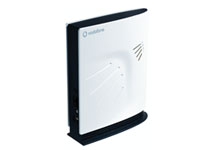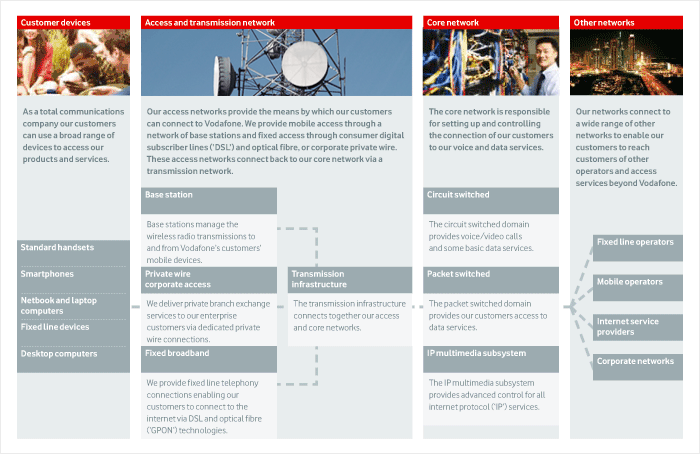Technology and resources
Our key technologies and resources include the telecommunications licences that we hold and the related network infrastructure which enable us to operate our telecommunications networks around the world.
Delivering the best customer experience
Our networks provide peak download speeds of up to 28.8 Mbps. We expect to provide ever faster speeds in the years to come.
We have built extensive coverage across our networks and strive to deliver the best possible user experience for our customers.
- Over 200,000 base station sites for the transmission of wireless signals.
- Network traffic of nearly 700 billion minutes and over 90 petabytes of data per year.
- Peak download speeds of up to 28.8 Mbps.
We continue to deliver a high quality customer experience across all of our markets, leveraging the extensive knowledge and expertise that we have across the Group. We measure key performance indicators across our markets on an ongoing basis to ensure we maintain high standards of service quality and availability. We also participate in regular network drive test campaigns conducted by independent third party companies to benchmark our networks against those of our major competitors.
Over the last year we have introduced advanced tools across all of our established 3G markets in Europe providing us with the ability to monitor and proactively manage our customers’ experience on the network.
Network infrastructure
Our network infrastructure provides the means of delivering our mobile and fixed voice, messaging and data services to our customers. Our customers are linked via the access part of the network which connects to the core network that manages the set-up and routing of calls, transfer of messages and data connections.
Second generation (‘2G’)
We operate 2G networks in all of our mobile operating subsidiaries through global system for mobile (‘GSM’) networks, offering customers services such as voice, text messaging and basic data services. In addition, all of the Group’s controlled networks operate general packet radio services (‘GPRS’), often referred to as 2.5G. GPRS allows mobile devices to be used for sending and receiving data over an IP based network and enabling data service offers such as internet and email access. In a number of networks, we also provide an advanced version of GPRS called enhanced data rates for GSM evolution (‘EDGE’). These networks provide download speeds of over 200 kilobits per second (‘kbps’) to our customers.
Third generation (‘3G’)
Our 3G networks, operating the wideband code division multiple access (‘W-CDMA’) standard, provide customers with an optimised data access experience. We have continued to expand our service offering on 3G networks, which provide high speed internet and email access, video telephony, full track music downloads, mobile TV and other data services in addition to existing voice and basic data connectivity services.
High speed packet access (‘HSPA’)
HSPA is a 3G wireless technology enhancement enabling significant increases in data transmission speeds. It provides increased mobile data traffic capacity and improves the customer experience through the availability of 3G broadband services and significantly shorter data transfer times. All of our markets with 3G capability now support the 3.6 mega bits per second (‘Mbps’) peak speed evolution of high speed downlink packet access (‘HSDPA’) and with peak speeds of up to 28.8 Mbps peak speed in some areas. The figures are theoretical peak rates deliverable by the technology in ideal radio conditions with no customer contention for resources. While HSDPA focuses on the downlink (network to mobile), high speed uplink packet access (‘HSUPA’) focuses on the uplink (mobile to network) and peak speeds of up to 1.4 Mbps on the uplink are now available across all of our markets, with peak speeds up to 5.8 Mbps available in key areas across many of our 3G networks.
Evolving our networks
Population coverage in Europe
99%
with 2G and over 80% with 3G
We continually improve our network and IT capability in order to enhance the service we provide our customers.
With the increasing adoption of mobile broadband services and the wider availability of advanced smartphones we are seeing accelerated growth in data traffic across our networks. To ensure we continue to deliver the best possible quality of service to our customers we are proactively evolving our infrastructure through a range of initiatives.
Access network evolution
We are actively driving additional 3G data technology enhancements to further improve the customer’s experience and capacity of our networks including evolutions of HSPA technology to increase both the downlink and uplink speeds. We have successfully trialled evolutions of mobile broadband technology delivering peak rates of 43.2 Mbps. During the 2011 financial year we expect to extend the availability of 28.8 Mbps downlink and 5.8 Mbps uplink speeds within our network.
We have continued to expand our fixed line footprint in accordance with our total communications strategy by building our own network and/or using wholesale arrangements in 13 countries at 31 March 2010.
Transmission network evolution
We continue to upgrade our access transmission infrastructure from the base stations to the core switching network to deal with the increasing bandwidth demands of the access network. We have continued to pursue a strategy of implementing scalable and cost effective self-build solutions and are also leveraging our DSL interests by increasingly backhauling data traffic onto more cost effective DSL transport connections. During the 2010 financial year we also introduced new high capacity ethernet microwave solutions into our access transmission network and continued to deploy high bandwidth optical fibre more widely across our access transmission network. In the core transmission network we have continued to expand our high capacity optical fibre infrastructure, including technology enhancements, which enable the use of cost effective IP technology to achieve high quality transport of both voice and data traffic.
Core network evolution
At 31 March 2010 we had consolidated 15 national IP networks into a single IP backbone, including all markets in our Europe region, centralising IP operations to avoid duplication and achieve simplicity and flexibility in the deployment of new services to serve multiple markets. We have also introduced advanced yield management capabilities across substantially all of our established 3G markets. This provides us with the ability to actively manage the capacity allocated in our networks in order to optimise the overall customer experience we deliver.
We have continued to expand the deployments of IP multimedia subsystem (‘IMS’) infrastructure across these markets in order to serve the increasing demand for advanced internet based services and applications.
Licences
The licences held across our operating companies enable us to deliver fixed and mobile communication services. Further detail on the issue and regulation of licences and a table summarising the most significant mobile licences held by operating subsidiaries and the joint venture in Italy at 31 March 2010 can be found in “Regulation”. In addition, we also have licences to provide fixed line services in many of the countries in which we operate.
We regularly assess the value of our spectrum holdings and participate in auctions to supplement our holdings on a case-by-case basis.
Innovation

Product focus: Vodafone Sure Signal boosts your mobile signal at home or work.
All you need is a home broadband connection, a 3G phone and our easy-to-install Vodafone Sure Signal box.
We are a pioneer in products and services to enhance customer choice and user experience.
Quality of service for data applications
We have been driving the development of quality of service differentiation in 3G which enables us to carefully manage the assignment of capacity in our networks during the busiest times. With increasing data demands, driven by faster HSDPA and fixed broadband, this capability enables us to manage our costs through intelligent allocation of network resources. We have already launched quality of service differentiation to customers in Spain and Romania and plan further launches across the majority of our 3G footprint.
Femtocells
At 31 March 2010 we had femtocells in service in the UK and Qatar and continue to trial the product in several other markets. Available as Vodafone Sure Signal in the UK, these innovative devices provide a personal 3G mobile phone signal to our customers by connecting to our core network and services via their household broadband connection, providing enhanced coverage to our customers in areas where mobile operators are unable to give customers a strong enough signal in their homes.
IT
As we integrate fixed and mobile services together, and as the web becomes increasingly mobile, IT has become a key enabler for service innovation. New IT technologies, such as cloud-based services, which provide unlimited processing capabilities by utilising shared resources on the internet, and service oriented architecture solutions, are delivering new revenue generating services and a consistent and enriched user experience for our consumer and enterprise customers.
For example in September 2009 Vodafone 360 was launched across Europe which required a common set of interfaces for partners such as Google and Nokia. This architecture is expected to be the foundation for future innovative consumer and enterprise propositions.
Research and development

Solar panels powering our base stations in India
We are working hard to reduce our own carbon impact through increasing energy efficiency and use of renewable energy as well as behaving responsibly by seeking to manage environmental issues in our supply chain.
Research and development is oriented to incubate and deliver innovation to the business, from disruptive new technologies to incremental commercial enhancements. Supporting our strategic objectives we have undertaken significant and varied activities during the 2010 financial year. Highlights include:
- a way to use the mobile subscriber identity module (‘SIM’) card to simplify and authenticate secure virtual private network access to corporate networks;
- trials of next generation wireless technologies including GSM evolution, HSPA evolution and 4G;
- new machine-to-machine capabilities enabling us to deliver new services to our customers;
- near field communications (‘NFC’) tags that add new functionality to mobile handsets already in use;
- formation of the wholesale application community (‘WAC’) where innovative applications are developed through the global alliance of mobile operators and device manufacturers;
- participation in industry-wide initiatives to develop standards for 4G mobile communications;
- delivery of a mobile healthcare programme supporting our commercial and corporate responsibilities; and
- a series of prototypes which enhance the mobile experience (voice, video, gesture and data) by utilising cloud computing technologies.
Cost reduction
Proportion of new radio sites shared
75%
While evolving the Group’s infrastructure it is also important that we continue to have a tight control over our cost base. We have been actively driving a variety of initiatives which enable us to manage our network investments.
Infrastructure sharing
Significant effort has been placed in reducing the costs of deploying mobile network infrastructure and we are now conducting network sharing in all of our controlled markets as well as securing network sharing agreements on over 75% of the new radio sites we deployed across the Group in the 2010 financial year.
Transmission self build
We are driving significant reductions in our ongoing operational costs through our strategy of building our own high capacity backhaul transmission network as opposed to leasing capacity from third party network providers. We now own over 75% of the backhaul transmission network across the markets in our Europe region.
IT transformation
The IT transformation programme launched in the 2009 financial year is on track to deliver its targeted savings and business benefits. The main focus areas include moving towards a common delivery model, simplifying the use of applications to minimise complexity and implementing a standard unified communications toolset including video and audio conferencing on standard PCs.
Supply chain management
Handsets, network equipment, marketing and IT services account for the majority of our purchases, with the bulk of these from global suppliers. Our supply chain management (‘SCM’) team is responsible for managing our relationships with all suppliers (excluding handsets) and for providing cost benefits through utilisation of scale and scope.
Since the launch of our supplier performance programme, the performance of these global suppliers has improved year-on-year. The best performing suppliers are recognised annually during our supplier conference. Our SCM team was recently voted as one of the top 20 most admired companies for “buy negotiation” by a study run by the International Association for Contract & Commercial Management.
SCM is a major contributor to our cost reduction programme and operates across all local markets, achieving savings that are measured using a unified methodology and are reported regularly to the Executive Committee. SCM has been operating its strategic procurement function from the Vodafone Procurement Company (‘VPC’) in Luxembourg for over two years, driving increased standardisation and cost savings through the use of global price books and contracts, e-auctions and low cost network vendors. Worldwide independent benchmarking studies have shown our SCM team has achieved significant cost advantages and indicate that we are achieving best in class pricing for IT storage and servers. We also operate through the China Sourcing Centre which has achieved significant trading volumes further improving the Group’s cost base.
Our suppliers are expected to comply with the Group’s Code of Ethical Purchasing as well as stringent health and safety plans. Further detail on this can be found in “Corporate responsibility”.
It is our policy to agree terms of transactions, including payment terms, with suppliers and it is our normal practice that payment is made accordingly.



 © Copyright Vodafone 2010
© Copyright Vodafone 2010